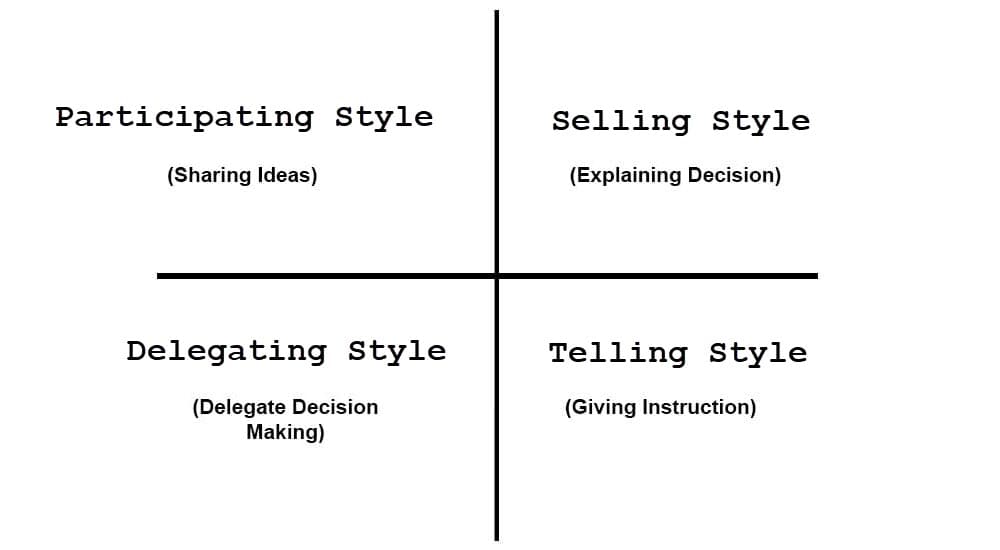Paul Hersey and Ken Blanchard introduced the “Life cycle theory of leadership” in 1969. Afterward, they renamed the theory “situational leadership.” However, it is still famously known as the Heresy and Blanchard Model.
According to them,
“The Hersey-Blanchard Situational Leadership Model allows business executives and leaders to be flexible in their leadership approach and exercise their authority over their followers. In addition, this leadership model provides managers with the tools needed to lead an organization for efficiency and optimum results successfully.”
This theory says there is no one-size-fits-all approach to leadership. Leadership styles should be adapted based on the unique situation of leaders, subordinates, and their capabilities.
According to this theory, leadership is not static but flexible and adaptive. Effective leaders measure factors such as the task, the nature of the individual or group, etc., and their relationship with employees before choosing a leadership style that fits the situation.
Analyzing the Hersey-Blanchard Model
The Hersey-Blanchard Model adopts a flexible leadership style that fits dynamic factors and the needs of employees and suits the maturity level of followers.
For example, if a follower’s maturity level is low, the leader should provide concise instructions and supervise the follower closely to ensure the successful completion of the task. Alternatively, if a follower is mature, the leader may delegate tasks with minimal guidance.
This leadership model thrives on the capability and willingness of individual followers.
The ability and willingness of followers depend on their level of competence, which is dependent on their maturity level, which determines the leadership style.
The Hersey-Blanchard Model identifies three levels of maturity: high, moderate, and low. These maturity levels are classified into M1, M2, M3, and M4.
- M1: In maturity level one, employees lack the willingness, skills, and knowledge to complete the task. The leader employs a leadership approach instructing the employee on finishing the task.
- M2: Group members are willing and eager to do the task but lack the expertise or experience. The leader employs a guiding leadership style at this maturity level.
- M3: Employees who fall into this category have the skills and experience to do the assigned task but are unwilling to take responsibility due to a lack of motivation, belief in personal abilities, and self-confidence. Here, leaders will select a style to motivate employees and boost their confidence.
- M4: This is the topmost maturity level. Employees in this category have a high level of ability, experience, and willingness to carry out the task. This lets the leader hand over responsibilities to the employees because they are capable.
Hersey-Blanchard Model and Leadership Styles

The Hersey-Blanchard Leadership Model adopts four leadership styles, depending on the maturity level of followers:
Telling (S1): This leadership style tells followers what they should do. The leader gives explicit instructions on what needs to be done and supervises the task closely. In the Telling Leadership Style, Task Behavior is at a high level, and Relationship Behavior is at a low level.
A follower’s maturity level is low in this leadership style, and the leader makes the decisions.
Selling (S2): This style is called the coaching or explaining style. This leadership style is characterized by leaders trying to ‘sell’ their ideas to followers. Here, followers have low to medium maturity, high motivation, and willingness to do the job.
Leaders persuade their followers about the importance of the task and how they should do it. This approach involves a high-task, high-relationship style where leaders coach and keep followers motivated throughout the task.
Participating (S3): In the Participating Leadership Style approach, leaders allow followers to make decisions actively. This model involves Relationship Behavior and a limited level of Task Behavior. Followers are given more tasks and freedom than the two previous styles.
In this approach, followers have a higher level of maturity and experience but lack confidence and commitment. This style, also known as the facilitating or collaborating leadership style, allows followers to display their level of responsibility and commitment.
Delegating (S4): The Delegating Leadership Style involves a hands-off approach to leadership; followers can make most decisions and take responsibility for the outcomes. In this style, followers have a high maturity level and are highly capable and motivated.
The approach involves a low level of both task behavior and relationship behavior; followers are highly experienced and can perform tasks with minimal supervision, and they also have the willingness and confidence to do so. The Delegating Leadership style is also known as the empowering or monitoring style.
Advantages and Disadvantages of the Hersey-Blanchard Model
Although the Hersey-Blanchard Model is sound in theory and highly regarded among professionals, it has some shortcomings and poses challenges in applying its principles in the real world.
Below are the advantages and disadvantages of the Hersey-Blanchard Situational Leadership Model.
Advantages
Easy to Understand: The primary concepts of the Hersey-Blanchard Situational Leadership approach are easy to understand. Instead of many confusing factors, the leader focuses on two variables: the task to be done and the group he is leading.
The group he is leading can be classified into four maturity levels, and the Hersey-Blanchard Leadership Model highlights the best approach for each category of followers.
Easy to Adopt: The Hersey-Blanchard Leadership Model is simple and easy to adopt; a leader can evaluate a situation and decide the leadership style that fits the situation. If the situation or a follower’s capabilities and maturity level change, the leader can also change the leadership style.
Flexible and Fast Implementation: This model allows for fast implementation. Once followers’ maturity and experience level have been determined, a suitable leadership style can be chosen and implemented.
Dynamic: The Hersey-Blanchard approach is dynamic. It can handle both straightforward and complex issues. A leader assigns tasks and responsibilities based on followers’ experience and commitment. It provides the leader with various alternative leadership styles that adapt and deal with different scenarios.
Increases Attentiveness and Empathy: Situational leadership requires constant involvement with followers. A leader must pay extra attention and communicate with them, observing their mood, morale, and motivational fluctuations.
Part of a leader’s job is to encourage followers and boost their morale to increase productivity, but doing this also hones his skills as an empathetic leader and helps him to be more attentive.
Disadvantages
Many Responsibilities: Adopting a different leadership approach to every individual may strain the leader. Also, since this style is highly focused on the individual, it may be challenging for a leader to apply it to a group of people with varying levels of maturity and capabilities.
This leadership approach may task employees with roles and responsibilities they are not ready for. Also, if a leader misjudges a situation and implements the wrong leadership style for a group of people, the outcome may be harmful.
Inability to Adapt: A leader might have difficulty changing from the set leadership style that he has established over time and adapting to the Hersey-Blanchard Leadership approach.
Focus is Placed On the Employee: The Hersey-Blanchard Leadership Model emphasizes how the leader relates to his employees, how he adapts his style to suit the strengths and weaknesses of his employees, and how he motivates and improves their maturity level. This requires the leader to pay extra attention to the members of his group, which might overload the leader.
Frequent Changes May Cause Confusion: When a leader goes from one leadership style to another when handling different projects, employees may feel confused and not know what’s coming next. Therefore, leaders must communicate what is coming next to avoid confusion. This takes time, which most leaders don’t have.
Doesn’t Focus on The Long-Term: The situational leadership model requires a leader to focus on the given task. Therefore, his leadership approach is based on that task and the experience and maturity level of the team in that current situation.
This might pose a danger for a leader attempting to establish a distinct corporate culture. If his focus is here and now, he risks losing the group’s and the company’s short, medium, or long-term goals.
Applying the Model Hersey-Blanchard and Its Limitations
The Hersey-Blanchard Leadership Model allows leaders to adopt a unique approach to exercising authority over followers. In this model, individual followers are led based on their strengths and weaknesses, maturity, experience, commitment, and willingness to do the job.
This model allows leaders to bring out the best in individual followers. Using the right applications helps employees to the best of their capability.
As effective as this theory sounds, it has some limitations in the real world. Many factors impact the effectiveness of the Hersey-Blanchard Situational Leadership Model. Managing many employees and determining the best approach based on their maturity levels takes a lot of time and resources.
Also, people are unpredictable, and their maturity levels change often. What a leader thinks he knows about an employee today might no longer apply to that employee tomorrow; the leader needs to start a new evaluation process.
Mostly, instruction comes from top management, and the leader has to follow the direction based on this instruction and not their preferences.
Other factors include limited availability of resources and a narrow field of options; all these can make it hard for managers and leaders to apply the Hersey-Blanchard Leadership Model successfully.
Conclusion
In today’s dynamic, ever-changing business environment, organizations have to adopt the best business models according to the needs of their followers for smooth operations and maximum profit. This model has been tested, improved, and adjusted since its release.
The Hersey-Blanchard Situational Model of Leadership focuses on flexibility and helps businesses maximize the performance of their employees and achieve an optimal output.
Although the Hersey-Blanchard Situational Model of Leadership has its downsides, its advantages are considered an overall benefit in choosing leadership in situations where one can apply it, especially in small, growing organizations. A leader adopting this leadership model is prepared to deal with versatile scenarios and work out approaches explicitly crafted for the conditions in which the leader has to operate.
